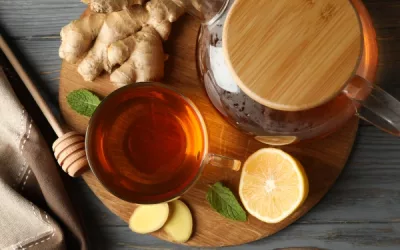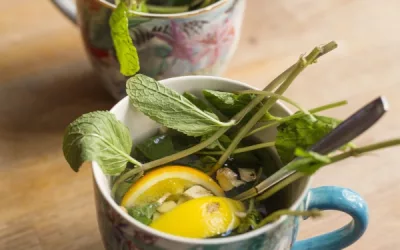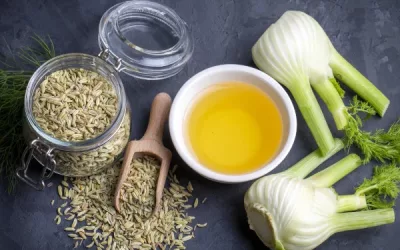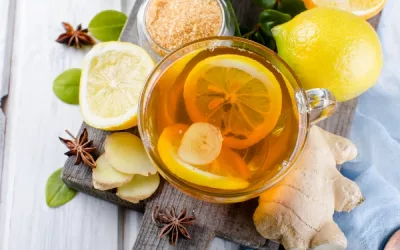Did you know that turmeric, often lauded as a superfood, has been a staple in traditional medicine for centuries? As health-conscious individuals increasingly seek natural remedies, turmeric tea emerges as a refreshing elixir packed with benefits. This guide will delve into the myriad advantages of turmeric tea, offering recipes, practical tips, and insights into its remarkable properties. Whether you’re looking to enhance your wellness or simply enjoy a soothing drink, this article will cover everything you need to know about turmeric tea’s potential.
Table of Content
What is tumeric tea?
Turmeric tea is a warm beverage made from the bright yellow-orange spice turmeric, derived from the root of the *Curcuma longa* plant. Known for its strong anti-inflammatory and antioxidant properties, turmeric contains an active compound called curcumin, which is believed to offer various health benefits. Often consumed as a remedy for conditions like arthritis, digestive issues, and colds, turmeric tea can be prepared by steeping ground turmeric or fresh turmeric root in hot water. Additional ingredients like ginger, lemon, honey, or black pepper are often added to enhance flavor and curcumin absorption.
Drinking turmeric tea regularly may support overall wellness by helping to reduce inflammation, boost the immune system, and improve digestion. Black pepper, which is often included in recipes, contains piperine, a compound that helps increase curcumin’s bioavailability, allowing the body to absorb it more effectively. The tea is commonly enjoyed in both traditional Ayurvedic medicine and modern wellness routines. Its earthy, slightly bitter taste can be balanced with natural sweeteners or spices, making it a comforting and health-promoting beverage.
Turmeric’s journey as a medicinal powerhouse is fascinating. In ancient India, people used turmeric in various forms for its health benefits. They honoured it not just for its vibrant colour but for its healing properties as well.
It was often used in religious ceremonies and traditional healing practices. Its high status in Indian culture shows how deeply it is embedded in their historical and medicinal traditions.
I remember the first time I tried making turmeric tea at home. I had just returned from a long hike and my muscles were sore. I brewed a pot of turmeric tea with a dash of black pepper (to boost curcumin absorption) and a drizzle of honey.
The warm, slightly spicy beverage not only soothed my body but also provided a sense of comfort and relaxation. Since then, it has become a staple in my daily routine, especially on chilly mornings or after a strenuous workout.
It’s amazing how a simple cup of tea can make such a difference in your wellbeing.
How to make the perfect turmeric tea?
Turmeric tea, known for its vibrant colour and numerous health benefits, is a delightful and easy-to-make beverage. This tea can help improve digestion, boost immunity, and reduce inflammation due to its active component, curcumin. Here’s a step-by-step guide to help you brew the perfect turmeric tea at home.
The step-by-step guide to making turmeric tea
To get started, you’ll need a few simple ingredients and a little bit of time. Below is a comprehensive table that outlines everything you need to know, from the ingredients to the preparation and cooking times, and the detailed steps to follow. This table provides a clear and easy-to-read format to ensure you can whip up a perfect cup of turmeric tea without any hassle.
| Ingredient | Quantity | Preparation Time | Cooking Time | Instructions |
|---|---|---|---|---|
| Turmeric powder | 1 teaspoon | 2 minutes | 10 minutes | Add to boiling water |
| Fresh ginger | 1-inch piece, grated | 1-2 minutes | 10 minutes | Add to boiling water |
| Black pepper | A pinch | 1 minute | 10 minutes | Add to boiling water |
| Cinnamon stick | 1 stick | 1 minute | 10 minutes | Add to boiling water |
| Honey | 1 teaspoon | 1 minute | 0 minutes | Stir in after boiling |
| Lemon juice | 1 tablespoon | 1 minute | 0 minutes | Stir in after boiling |
| Water | 2 cups | 0 minutes | 10 minutes | Boil |
To understand the table:
- Ingredient: Lists what you need.
- Quantity: Shows the amount required for each ingredient.
- Preparation Time: Indicates the time needed to prepare each ingredient.
- Cooking Time: Denotes the time each ingredient needs to be cooked.
- Instructions: Provides the steps to follow during the preparation and cooking process.
What are the health benefits of turmeric tea?
Turmeric tea offers a range of health benefits that make it worth incorporating into your daily routine. Here’s why you might want to consider making it a regular addition to your beverage repertoire:
- Anti-inflammatory properties: Turmeric contains curcumin, known for reducing inflammation.
- Boosts immunity: Helps to strengthen the immune system.
- Aids digestion: Can improve digestion and soothe upset stomachs.
- Antioxidant-rich: Protects cells from damage by free radicals.
- Supports heart health: May improve cardiovascular health.
In addition to these health benefits, turmeric tea is also incredibly versatile and can be customised with various spices and sweeteners to suit your taste preferences.
What variations can you try for turmeric tea?
There are many ways to modify your turmeric tea to make it more exciting and suited to your taste. Here are some variations you can try:
- Coconut Milk: For a creamy texture, add coconut milk.
- Peppermint: Add fresh peppermint leaves for a refreshing twist.
- Cardamom: Introduce a hint of sweetness with cardamom pods.
- Apple Cider Vinegar: Enhance the health benefits with a splash of apple cider vinegar.
- Maple Syrup: Use maple syrup instead of honey for a different kind of sweetness.
Experimenting with various additions can make each cup of turmeric tea a new and delightful experience.
During the golden age of the Silk Road, traders would often carry turmeric from India to the Middle East and Europe. The spice was highly valued for its medicinal properties, and it was not uncommon for travellers to brew turmeric tea to fortify themselves against the rigours of long journeys.
One famous explorer, Marco Polo, documented his fascination with turmeric during his travels in the 13th century, noting its vibrant colour and potent healing qualities.
As for me, I discovered the joys of turmeric tea during a trip to India. I was staying at a homestay in Kerala, where my host brewed a fresh pot every morning. The aroma of the spices mingling with the morning air was unforgettable.
Since then, making turmeric tea has become a cherished ritual, especially on cold days when I need a warm, comforting drink. The process of brewing the tea and the knowledge of its benefits make each sip a small act of self-care.
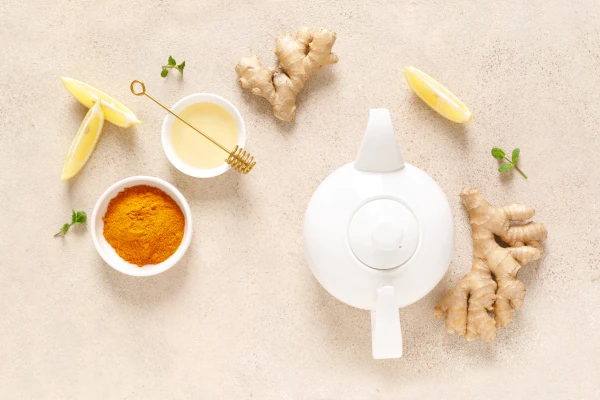
What are the different variations of turmeric tea?
Turmeric tea isn’t your average cuppa. It’s a versatile brew that can be customised in numerous mouth-watering and health-boosting ways. Let’s dive into some popular variations and how they can transform your tea experience.
First off, adding a touch of ginger transforms your turmeric tea into a zesty, warming beverage. Ginger not only boosts the tea’s anti-inflammatory benefits but also gives it a bit of zing that’ll tickle your taste buds. Think of it as the tea’s spicy sidekick.
Next up, citrus zest. We’re talking lemon, lime, or even orange peel. This addition doesn’t just make your tea smell divine but also ups the ante with a hefty dose of Vitamin C. Plus, it adds a refreshing note that brightens up the earthy taste of turmeric.
Sweeteners are another way to customise your turmeric tea. Honey, agave syrup, or even a splash of maple syrup can add a touch of sweetness without overloading on sugar. Each sweetener brings its own unique flavour to the mix, making each sip a little adventure.
Then, there’s the dairy or non-dairy debate. Whether you go for traditional milk, almond milk, or coconut milk, adding a bit of creaminess can turn your tea into a soothing latte. It’s perfect for cosy evenings or as a calming morning pick-me-up.
Last but not least, spices like cinnamon or black pepper can take your turmeric tea to another level. Black pepper enhances turmeric’s bioavailability, meaning your body can absorb it better. Cinnamon, on the other hand, adds a warm, sweet-spicy flavour that complements the turmeric beautifully.
How does adding ginger enhance turmeric tea?
Incorporating ginger into your turmeric tea isn’t just for an added kick. Ginger brings a host of benefits that make your tea both tastier and healthier.
- Combines zingy freshness with the rich, earthy tones of turmeric
- Amplifies the anti-inflammatory properties, working in tandem with turmeric
- Helps in digestion and soothes any tummy troubles
- Adds a delightful spicy aroma that elevates the whole experience
- Works as a natural cold and flu fighter, providing relief during sickness
Combining ginger with turmeric is akin to pairing Batman with Robin; they complement each other perfectly. Ginger makes the tea more exciting to drink while doubling down on the health perks.
What are the benefits of using citrus zest in turmeric tea?
Adding citrus zest isn’t just about upping the flavour game. It turns your turmeric tea into a vitamin-rich elixir.
- Brings a refreshing tang to balance turmeric’s earthiness
- Packs a punch of Vitamin C, boosting your immune system
- Acts as an antioxidant, fighting off those pesky free radicals
- Enhances the smell, making each sip a more aromatic experience
- Lends the tea a light, revitalising quality that’s especially refreshing
Citrus zest also adds a vibrant twist, making your tea feel like a gourmet beverage. It’s a simple hack to turn an ordinary drink into something extraordinary.
Which sweeteners are best for turmeric tea?
Let’s talk sweeteners. Not all sweeteners are created equal, especially when it comes to turmeric tea.
- Honey: Antibacterial, adds natural sweetness without overpowering the flavour
- Agave syrup: Low glycaemic index, vegan-friendly option
- Maple syrup: Rich and slightly smoky, pairs well with the earthiness of turmeric
- Stevia: Zero-calorie option, doesn’t spike blood sugar levels
- Coconut sugar: Low glycaemic index, brings a subtle caramel flavour
The right sweetener can take your turmeric tea from good to absolutely fantastic. Each option has its own personality, so don’t be afraid to mix things up and find your favourite combination.
Back in the 16th century, Queen Elizabeth I was intrigued by exotic spices and herbs from the East, including turmeric. She had an Indian servant who prepared a special turmeric tea for her that included ginger and honey.
This unique blend soothed her throat and was reputed to improve her complexion. As a result, Elizabeth included it as part of her daily regimen. The Queen’s curiosity and appreciation for global flavours contributed to the popularisation of many new spices and herbs in English cuisine.
So, when you sip on your customised turmeric tea, know that you’re partaking in a tradition as storied as history itself. Cheers!
Is it safe to drink turmeric tea daily?
Drinking turmeric tea daily can be a delightful ritual that’s not just good for your taste buds but also your overall health. But, let’s not kid ourselves; the golden rule “too much of a good thing” applies to turmeric tea as well.
Now, let’s dive into the nitty-gritty, including the recommended daily intake, potential medication interactions, common side effects, and any long-term impacts.
Turmeric tea has anti-inflammatory and antioxidant properties that can give your health a boost. But despite being as trendy as avocado toast, it does come with some caveats.
When it comes to the recommended daily intake, stick to about 1-1.5 grams of turmeric per day, which translates to around one cup of turmeric tea. Any more, and you might trade those wellness vibes for a stomach ache.
What is the recommended daily intake of turmeric tea?
The amount of turmeric you should consume daily is mostly about balance, just like juggling work, gym, and binge-watching your favourite shows.
- Dosage: Aim for 1-1.5 grams of turmeric powder per day, roughly a single cup.
- Timing: Having it once daily is sufficient, preferably on an empty stomach for better absorption.
- Consistency: Regular but not excessive use is key. You’re not training for an Olympic turmeric consumption event here.
- Other liquids: Complement your turmeric tea with plenty of water to help balance any potential dehydrating effects.
- Variety: Spice up your life (pun intended) with other healthy teas or beverages rather than overloading on turmeric.
So, pour that cup wisely. You want those health benefits—not an unnecessary trip to the loo.
Are there any medications that interact with turmeric tea?
When it comes to mixing turmeric tea with medication, tread carefully. Turmeric is the ultimate multitasker: anti-inflammatory, antioxidant, and potentially, your medicine cabinet’s worst nightmare.
- Blood Thinners: Turmeric can enhance the effects of drugs like warfarin or aspirin, making you see blood where you’ve never bled before.
- Diabetes Medications: It can lower blood sugar, which might turn your blood sugar levels into an unpredictable roller coaster.
- Stomach Acid Reducers: Combining these with turmeric can reduce the efficacy of your meds, turning your heartburn into a bonfire.
- Anti-inflammatory Meds: You’d think same-same equals synergy, right? Wrong. It can amplify the effects, possibly overdoing it on the anti-inflammatory front.
- Radiation Therapy: Turmeric can act as a radio-sensitizer, potentially making cancer treatments more effective but also more dicey.
Always consult with your healthcare provider. You don’t want to turn into an unintentional science experiment, after all.
What are the common side effects of drinking turmeric tea?
Before you guzzle down turmeric tea like it’s going out of style, let’s chat about side effects. Spoiler alert: they can be quite the mixed bag.
- Gastrointestinal Issues: Nausea, diarrhoea, and stomach cramping might be the unwanted guests at your turmeric tea party.
- Allergic Reactions: Hives, rashes, or even anaphylaxis could happen if you’re as unlucky as a person stepping on a Lego.
- Gallbladder Problems: Turmeric can exacerbate gallbladder issues. Not the kind of spicy action you want.
- Blood-Thinning: Overdoing it can thin your blood to the point where a paper cut feels like a dramatic battle wound.
- Iron Deficiency: Too much turmeric can interfere with iron absorption, leading to an energy slump that NO amount of coffee can fix.
A historical nugget worth mentioning: Ancient Indian Ayurvedic practices have lauded turmeric for centuries. The medicinal use of turmeric tea dates back over 4,000 years in South Asia.
Sages and healers used turmeric in their remedies, believing it to be a divine gift. Today, science is catching up with what traditional healers knew all along: turmeric tea is not just a trendy drink; it’s a time-tested remedy for better health.
What are the best recipes for turmeric tea?
Alright, let’s talk about turmeric tea, the golden elixir that’s become the darling of health-conscious folks and culinary adventurers alike. Turmeric tea isn’t just one recipe; it’s a myriad of warm, soothing concoctions.
Whether you’re craving the traditional route or looking to spice things up with some creative blends, there’s a turmeric tea recipe for everyone.
Let’s jump in and explore some delightful turmeric tea variations, including the classic turmeric tea, turmeric and ginger tea, turmeric and lemon tea, golden milk, and even an iced version.
What is the classic recipe for turmeric tea?
The classic turmeric tea is as straightforward as it gets, and it’s where all the magic begins. A simple recipe you can whip up in no time, yet it packs a punch in the flavour and health benefits department.
Here’s what you need:
- 2 cups of water
- 1 teaspoon of ground turmeric or a thumb-sized piece of fresh turmeric, grated
- A dash of black pepper (helps our bodies absorb the turmeric)
- Honey to taste (optional)
- A splash of coconut milk (if you want to go creamy)
Steps:
- Bring the water to a boil.
- Add the turmeric (ground or fresh) and reduce the heat.
- Let it simmer for about 10 minutes.
- Strain the tea into your cup.
- Add a dash of black pepper, a bit of honey for sweetness, and a splash of coconut milk if desired.
Voilà, classic turmeric tea ready to sip!
How to make turmeric and ginger tea?
Combining ginger with turmeric is a match made in health heaven. Both boast significant anti-inflammatory properties and together, they create a zesty, invigorating tea.
You’ll need:
- 2 cups of water
- 1 teaspoon of ground turmeric or fresh turmeric, grated
- 1 teaspoon of ground ginger or a thumb-sized piece of fresh ginger, grated
- A dash of black pepper
- A spoonful of honey (optional)
- Lemon juice (optional)
Steps:
- Boil the water in a small pot.
- Add the turmeric and ginger.
- Allow it to simmer for 10 minutes.
- Strain the mixture into your cup.
- Add a dash of black pepper, and honey for sweetness.
- A squeeze of lemon juice can add a refreshing twist.
This brew will warm you up on a cold day and give your immune system a bit of a turbo boost.
What are the benefits of turmeric and lemon tea?
Turmeric and lemon tea is not just about taste. This tangy version is a superb way to reap a variety of health benefits. You get the anti-inflammatory and antioxidant benefits of turmeric, and the vitamin C and detoxifying benefits from lemon.
Benefits include:
- Boosts immune system with a powerful dose of antioxidants.
- Acts as a natural anti-inflammatory, fighting inflammation.
- Aids digestion by stimulating bile production.
- Detoxifies, helping to cleanse your body.
- Provides a natural energy boost, perfect for your morning routine.
The combination makes this tea not only delicious but a powerhouse for your health.
The recipe:
- 2 cups of water
- 1 teaspoon of ground turmeric or fresh turmeric, grated
- Juice of half a lemon
- A dash of black pepper
- Honey to taste (optional)
Steps:
- Boil the water.
- Add the turmeric and let it simmer for 10 minutes.
- Strain the tea.
- Add lemon juice, black pepper, and honey.
Sip on this invigorating tea and enjoy its myriad benefits.
And if you fancy a historic twist, consider this. Ancient Ayurvedic scripts dating back to nearly 2500 years mention the use of turmeric for health and cooking. One such script, the Charaka Samhita, dubs turmeric a powerful herb capable of balancing the doshas (the elemental energies structuring the body). They certainly knew a thing or two about wellness back then!
Happy tea-making!
How to store and preserve turmeric tea?
So, you’ve fallen in love with turmeric tea, the golden elixir of health aficionados everywhere. But now you’re wondering how to keep this magical brew in tip-top shape. Fear not, for I’m here to guide you through the labyrinth of storage and preservation. Let’s dive right into it, shall we?
First things first, storage is all about keeping things fresh, aromatic, and nutritious. Think of it like storing a treasure chest. Keep it high and dry, away from moisture and light – unless you want moldy goo instead of a health drink.
For optimal storage conditions, we’re talking dry, airtight containers. Fresh turmeric, like your gym socks, needs to breathe. But dried ingredients? Seal ’em up tight. A glass jar or even those fancy vacuum-sealed bags work wonders.
What are the optimal storage conditions for turmeric tea?
Get your storage game right, and your turmeric tea will remain as potent as the day you made it. Here’s the rundown:
- Keep it dry: Turmeric hates moisture like a cat hates water.
- Airtight containers: Oxygen is its arch-nemesis.
- Dark places: Sunlight is an ingredient killer.
- Cool temperatures: Room temp is fine; you’re not storing a snowman.
Fresh turmeric should be stored in the fridge, preferably in the vegetable drawer. Wrap it in a paper towel to keep it from getting too moist. In contrast, dried turmeric is a bit more forgiving. A dark pantry corner will do.
How long do fresh and dried ingredients last?
Ah, the age-old question, “How long is too long?” Let’s put it to rest.
- Fresh turmeric: Typically lasts about two weeks in the fridge.
- Dried turmeric powder: Good for up to 6 months if stored properly.
- Turmeric tea (pre-made): Keeps for about 3-5 days in the refrigerator.
Note: Always check for signs of spoilage. Fresh turmeric will get mushy, and tea might start to smell funky. When in doubt, chuck it out.
Can turmeric tea be frozen and reheated?
You bet your golden halo it can! Freezing turmeric tea isn’t just possible; it’s genius. Research shows that freezing actually preserves nutrients. But here’s the kicker: reheating it right.
- Freeze in portions: Ice cube trays work wonders.
- Use freezer-friendly containers: No flimsy sandwich bags.
- Label everything: “Mystery Ice Cube” isn’t a flavour.
- Reheat gently: Avoid boiling; it messes with the flavour.
Frozen turmeric tea cubes can be plopped into a pot on low heat. Gradually warm it up to sip-ready temperature, and you’ll retain most of its nutritional goodness. Just don’t nuke it in the microwave; that’s like using a blowtorch to light a candle.
In 1875, a bust of Nefertiti was found depicting her as the queen of Egypt. This bust was not discovered in mint condition but was carefully preserved to showcase its majestic beauty. The meticulous care taken then mirrors our efforts today in storing and preserving turmeric tea.
When done right, both can last through the ages – one as a timeless beauty, and the other as your go-to health brew.
Conclusion
In exploring the myriad benefits and delightful variations of turmeric tea, I’ve come to appreciate this vibrant infusion not just as a health elixir, but as a versatile beverage that can easily be woven into our daily routines.
From its impressive anti-inflammatory and antioxidant properties to its potential in aiding digestion and weight loss, turmeric tea stands out as a worthy contender in the quest for improved well-being.
I hope I’ve conveyed the essence of why integrating turmeric tea into our diets is a meaningful choice. The insights gained through examining the health benefits—particularly its role in immune support and detoxification—highlight its importance not only for individuals seeking natural remedies but also for those simply looking to enhance their overall health. Furthermore, with its various recipes, from classic blends to invigorating ginger-infused concoctions, there’s truly a flavour for everyone.
For those curious about long-term consumption, being mindful of the recommended daily intake and potential interactions with medications is key. This knowledge empowers us to incorporate such a powerful ingredient safely.
As we reflect on the impact of small changes in our dietary habits, I invite you to consider: what other simple indulgences could enhance your health journey? After all, every cup of tea serves as an invitation to pause, breathe, and acknowledge the small steps we can take towards a healthier lifestyle. Perhaps the next time you sip your turmeric tea, you could savour not just its warmth and flavour, but also the wellness it supports.
Resources
- The Immunomodulatory and Anti-Inflammatory Effect of Curcumin on Immune Cell Populations, Cytokines, and In Vivo Models of Rheumatoid Arthritis
- Safety and anti-inflammatory activity of curcumin: a component of turmeric
- Curcumin: A Review of Its’ Effects on Human Health
- Turmeric and Its Major Compound Curcumin on Health: Bioactive Effects and Safety Profiles for Food, Pharmaceutical, Biotechnological and Medicinal Applications
- A systematic review of the efficacy and safety of turmeric in the treatment of digestive disorders
- Therapeutic effects of turmeric or curcumin extract on pain and function for individuals with knee osteoarthritis: a systematic review
- Anti-Inflammatory Effects of Curcumin in the Inflammatory Diseases: Status, Limitations and Countermeasures
- Turmeric benefits: A look at the evidence
- Turmeric Tea: Is It Good For You?
- Antioxidant and anti-inflammatory effects of curcumin/turmeric


